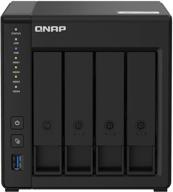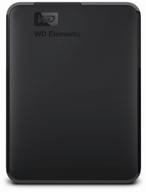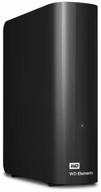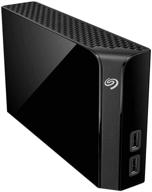
Review on 💾 WD Diskless My Cloud EX4100 Expert Series NAS - Reliable 4-Bay Network Attached Storage for Efficient Data Management by Carlos Cardoso

Stylish little prosumer NAS (4-bay)
This review is for the WD EX4100 (4-bay) as Revain decided to combine the 2-bay and 4-bay reviews. A: After 6 months of use, I need to add the following information: 1. A disk error notification is displayed for disks that have no disks inserted. This can be mitigated somewhat by scheduling regular downtime.2. Write speed is (obviously) still limited by the hard drive and network connection used.3. WD's documentation is still not perfect and they still rely too much on group support boards. To enable dual binding on Gigabit ports, enable 802.3ad.5. You should not use old/personal discs. The WD RED 5400 RPM drive is probably the best choice for stability/durability over the 7200 RPM version - unless you opt for the WD Black.6 instead. Again, the "EX" in "EX4" stands for "Expert". For the less tech-savvy, this should be an indication that this is little more than a plug-and-play solution. The original review: First off, this device isn't as basic as some other types of devices designed for the home user. You have to invest time and intelligence to install and manage every business solution you purchase (hence the product EX for Expert uses). If you want things to work without doing more than clicking next in the setup wizard, this isn't for you. I decided to purchase this NAS after using a spare PC as a media server for a while. I bought the WD Red 8TB drive separately as it was cheaper than the bundled version of the EX4100 with two 4TB drives. The maximum storage capacity for this solution is 32 TB or 4 x 8 TB drives. For now I've decided to run JBOD with a separate backup for important files. The package contains an installation guide, which takes effect for about 15 seconds. You (the person installing it) are expected to go to the WD website to access the appropriate installation instructions. The setup itself isn't too complicated: insert disks; Power on (takes a minute to initialize); access control interface via a computer on the local network; configure RAID (even if JBOD); format disk; Set up "Shares" for storing files; and access shares through network discovery on your computer. One problem I had was the hard drive ticking every 5 seconds. According to the WD website, this is normal for their standby corporate drives. Your drives are pretty noisy (though most enterprise systems are, to be honest ;) and this may affect where you choose to place the device. You need to connect it to your router (assuming you are using a home router/switch). wap combination). A CAT-5 cable (a commercially available "network" or "ethernet" cable) can easily support 10 Mbps transmission, but 100 Mbps is unlikely if the cable is longer than a specific distance (or if you forgot to account for TCP overhead). With the cable I'm using, I'm seeing a 90Mbps transfer. That's 11MB/s, which is something to consider since files are measured in bytes, not bits (8 bits per byte; a 700MB file is 5600 MB). A gigabit cable is included, although (if required) it is 3 feet long. This is calculated at 125 MB/s, but you still need to consider the speed of all other transport sections. To use the car analogy, a Bugatti Veyron can't go 200 mph in traffic. If you want to transfer many files from an external device (such as a portable hard drive) to the NAS, I recommend plugging the device into a USB drive on the front of the NAS. Next, you need to go to the Control Panel through your computer. Use the "Backup" function to have the NAS copy files from the corresponding folders on the external device to the desired location on the NAS. This way you don't have to use your network or computer to copy files. With the "Backup" feature, you can also choose to automatically back up your important files to another location if you want to use this feature. For regular use, when copying small files one at a time, file sharing (via Network Discovery on your computer) works well. My biggest problem with the device is actually with its control interface. The default interface is port 80 and does not support connections over port 443 (HTTPS). This includes the login function and device management. You can enable SSH after setting up the device; but it doesn't change the above problem. The UI also lets you try to do things that might be predicted to fail, e.g. The site has a timeout feature, which is nice. However, I would not recommend this device for a true enterprise solution. For Plex users: This device works decently when streaming directly. If your files are in .mp4 (MP4 container) or .mkv format and use H264 (video playback) or H265 (HVEC) and AAC, MP3 or FLAC for audio, you can play the file just fine. .avi (AVI container) is not supported by the Plex client (because it costs money for a license) and also by DTS pass-through, so the media server will try to transcode it. The EX4100 is not powerful enough to transcode, so you cannot play such files using this device as a server. You can use a more powerful device (e.g. your computer) as a server and host files on the NAS; or use a tool like Handbrake to convert files to a direct playback format. In general I like the product. I think it does a good job of balancing enterprise functions with the needs of home use. The device's cost, initial setup requirements, lackluster documentation in the box, and lack of standard network security protocols are the biggest issues I see with this device.
- Ideal for outdoor activities
- Negative gift
New products
Comments (0)
Top products in 🗄️ Network Attached Storage

QNAP TS-451D2-4G 4-Bay 4K NAS with Intel Celeron J4025 CPU, Hardware Transcoding, and HDMI Output

16 Review
![zyxel nas326: personal cloud storage [2-bay] with remote access & media streaming – disks not included logo](https://images.revain.org/blob/revain_storaget1i45yp6_fce0cc3168@128x128.jpg)
Zyxel NAS326: Personal Cloud Storage [2-Bay] with Remote Access & Media Streaming – Disks Not Included

33 Review

📦 Enhance Your Network Storage with Synology 2-Bay NAS Disk Station DS218play (Diskless)

12 Review

💾 Diskless Synology DS118 NAS DiskStation with 1 Bay

18 Review
Another interesting products

2 TB External HDD Western Digital WD Elements Portable (WDBU), USB 3.0, black

84 Review

18 TB External HDD Western Digital WD Elements Desktop, USB 3.0, black

95 Review

🔜 Seagate Backup Plus Slim STHN2000400 2TB Portable Hard Drive - Black: Your Reliable External Storage Solution

93 Review

8TB Seagate Backup Plus Hub Desktop Hard Drive with Data Recovery Services

56 Review

